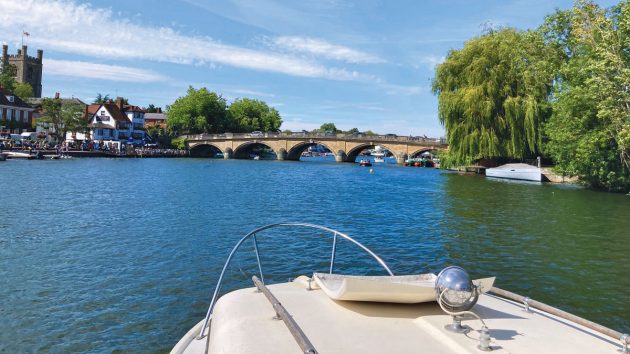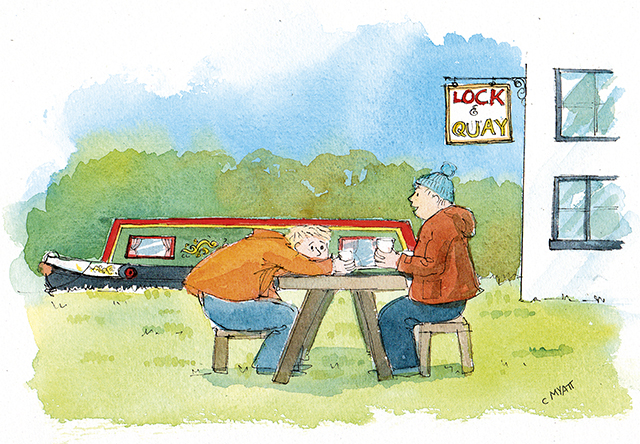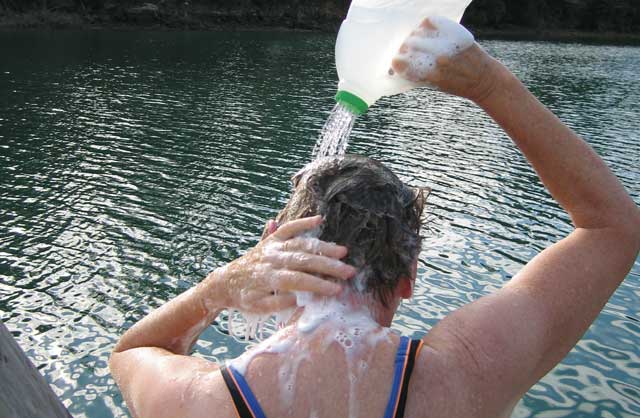Chris Colverson enjoys the sights when she spends 22 days aboard a 22ft river cruiser – from Shepperton Marina to the source of the River Thames and back, or at least as far as possible
What better way to spend the record-breakingly hot summer of 2022 than to take our cruiser on a 115-mile, 41-lock voyage from Shepperton Marina to the source of the River Thames and back, or at least as far as we could go?
Our beloved powerboat is just 22ft long and the journey would take 22 days, although we didn’t know that when we started. What we did know, since we are both in our seventies and I am disabled, was that I was not planning to disembark until we were home.
Our goal was Lechlade in Gloucestershire. The bubble of spring water generally considered to be the actual source of the Thames is further on in a field 12 miles past Cricklade, but unless you’re in a canoe, even Cricklade is impossible.
So for most boaters, the aim is to reach Ha’penny Bridge, beyond which the river is too shallow for navigation.

Chris at the helm by Chertsey Bridge
Fully loaded
We cast off by mid-afternoon on 5 July, with a hold full of bottled water, every cupboard crammed with food in packets, jars and tins, a small fridge for dairy stuff and boating essentials like sausages and bacon, and alcoholic refreshments.
Of course, we planned to buy fish and chips and other effortless suppers on the way, and we hoped that a riverside hostelry or two would bring dinner out to our boat, since it is difficult for me to get off Kay.
But you can’t rely on getting an available mooring for pub-grub, so we had victuals aplenty and enough petrol to get us to Reading.
Since we were self-sufficient, we were looking forward to waking to birdsong beside meadows and other uninhabited places.
The joy of it was not knowing how long it would take us. It felt like that once-in-a-lifetime thing, and it was!
Never mind the weather and gorgeous river conditions – the beauty of Runnymede, Windsor, Henley, Abingdon and Oxford. What most people want to know is: If you’re unable to stand without a stick or a walker, how do you get on board? How did you manage with just a Porta-Potti, no shower and no washing machine? What were the hazards?
Well, I can tell you that the main hazard in that heatwave was lunatic kids jumping off bridges and swimming straight for you, and that a shower-head attached to a hosepipe is a wonderful thing.
My husband, Ron, did all the energetic and clever stuff, and all the emptying of the chemical toilet at lock stations. I just held the odd rope in locks.

Ron at Bell Weir Lock
Love at first sight
We bought Kay in 2016, after a day trip out on a friend’s sailing craft reminded us just how blissful it feels getting in, on or near water.
We decided that Jerome K Jerome’s Three Men in a Boat was the way to go: up the Thames to Oxford, down to Kingston and then back to our home marina at Shepperton, aboard a compact, manageable vessel.
Viewing Kay was love at first sight: she was the dinkiest, prettiest holiday home on the river we could wish for.

Kay at Romney Lock. Bimini provides shade

A floating Wendy House, Kay’s interior has never looked this tidy again!
Oxford-bound
The first nine days of our 2022 odyssey took us from Shepperton to Oxford. All the locks are powered on this stretch of the Thames and many are manned.
I cannot recommend Shepperton (6ft 8in), Bell Weir (6ft), Boulter’s (7ft 9in) or Marlow (7ft 1in) locks single-handed at dusk when the lock-keeper has gone off duty, but on day one we made it to delightful Runnymede Meadow, having had the river largely to ourselves.
This stunning location has a densely wooded island on one side and an open field looking across to the Kennedy Memorial on the other.
Most boaters head off soon after daylight: we don’t. We are not in this for timetables and regulation hours!
So we pottered past lovely Datchet and manicured Home Park, the Royal Family’s back garden.

A very large yellow duck at Marsh Lock, Henley
Windsor was crowded with a variety of pleasure craft. Was that an amphibious bus floating by? Yes, along with all the frenetic swans, geese and hire boats, so we did not linger on our favourite mooring at the very tip of Baths Island (£8 per stay) for its breathtaking castle view.
Instead, it was a snack lunch from the river café, pausing to buy swan food before going through Boveney Lock to tie up near Eton College Rowing Centre. No mooring fees were asked of us. We woke to a glorious morning and no Prime Minister! Boris Johnson had resigned. Would it be Rishi Sunak or Liz Truss? Little did we know…
We topped up with petrol (27lt) at Bray Marina, then cruised past the mansions on the approach to Maidenhead; and under the astonishing brick-built railway arch constructed by Isambard Kingdom Brunel (and, we assume, numerous bricklayers, who must have hung upside down as they worked).
Past that was Boulter’s Lock, elegant, deep and flipping awkward to get into because you cannot see what is coming out.
The temperature was rising, but this most famous of Thames locks was less crowded than it sometimes is.

Sparkling Remenham
Unexpected festivities
Then it was onward to beautiful Cliveden Woods. You can find National Trust moorings along this stretch, but not by the time we arrived.
On to Bell Rope Meadow at Cookham, where the £7 fee was worth it for the capacious rubbish bins and very splendid take-away from The Peking Inn.
Our next destination was sparkling Remenham and its landscaped meadow just below Temple Island at Henley-on-Thames.
Ron walked into Henley and found the towpath full of people in formalwear, holding folding chairs and hampers because Henley Festival’s floating stage was hosting a concert. Our £12 mooring fee gave us a free Tom Jones performance!
The glorious sunset and nostalgic sound of the ‘Green, green grass of home’ were only marred after dark by a powerboat zooming past, which dislodged crockery with its wash and smashed one of our Freeman 1960s dinner plates, the stinker!
Off we went past the Masters’ Race on the Henley Regatta Course next morning, and by the glorious hollyhocks at Sonning Lock.
Our next stop was Reading, which has a Tesco fuel station close to its visitors’ mooring. Ron thankfully fetched two trolley-loads of petrol in cans – the last petrol we would find before Lechlade.
We were up early – Reading isn’t known for its peace and quiet – and filled up with water at Better Boating, opposite Tesco.
Soon we were into rolling Oxfordshire hills and meadows, with vast blue skies and temperatures in the 30s.
Past Mapledurham House and Pangbourne there was a long, lock-free curve at Beale Park and, it now being the weekend, the Great British public was out baring flesh or swimming.
It was easy to moor free just below Goring Lock. Kay has a stern ladder to facilitate bathing, but not being fit enough to use it, we just leaned over the side and hosed each other down!

The joy of uninhabited places
Beyond Goring, we aimed for Burcot, waving a fond farewell to a cruiser that had tailed us since Harleyford Marina. Somewhere alongside another great curve of the river, we moored for a full English supper.
Aside from munching cows and a jumping fish or two, the silence was profound. Ron took an improvised shower, with an upturned flagon of water and not much else.
After Burcot was a slow, picturesque glide to mediaeval Abingdon, where we stopped for lunch opposite The Cosener’s House. Culham Lock is difficult!
But Abingdon lock-keepers are blessed with hearty appetites and a good sense of humour, as evidenced by their sign.
Then it was onwards through sleepy woodland interspersed with banks of wildflowers to Sandford Lock, the deepest on the non-tidal Thames.
We’d arranged to meet our two sons at the pretty King’s Arms, a riverside pub in Sandford, so for the night we took advantage of the free mooring adjacent to their garden and treated ourselves to a proper chef’s dinner, which they did indeed deliver to our boat.
It was so good, we ordered their breakfast for the next morning as we waited for our boys.

Sons Jon and Dan joined Kay for a jaunt
There are few joys greater than picking up loved ones during a boating trip and taking them for a jaunt. Dan and Jon accompanied us past the college boathouses and Christ Church Meadow to Portmeadow.
We had to remove the bimini top, take the mast down and hold our breath to get under Osney Bridge (7ft 6in).
Thames proper Above the narrow arches of Folly Bridge, everything changes. The Thames, called the Isis within Oxford’s boundaries, reverts to being the Thames again.
At Portmeadow, the river becomes very wide and shallow, with ducks waddling about. Apart from water lilies and weeds, other hazards here included excited youngsters leaping off the weir bridge, paddling children, and people with dogs on paddleboards.
We dropped the lads off above the bridge and were back in town along the towpath for the night at Fiddler’s Stream. There was a Marks & Spencer nearby for milk and croissants.
Lechlade was two days away. At King’s Lock, where we stopped for water, the keeper informed us the remaining 10 locks would be unmanned and hand-operated, using a beam, your back and a paddle.

Hungry lock-keepers’ sign at Abingdon
Hard graft

Ron working Northmoor Lock
The unmanned locks took longer, too, because of all the walking back and forth to open and close sluices, and were hard graft for Ron. I just carried on drinking the Pimm’s.
Above Oxford, the river is narrower, shallower and much quieter. Miles and miles of meadows and woodland with only sheep, lambs, long-billed herons and coots for company.
At Eynsham Lock, we stopped for rubbish and sanitary disposal, and water, then cruised past Swinford to moor near Farmoor Reservoir.
With only seven miles to go to Lechlade, the river twisted and narrowed. We buffered the scorching rays with a large, handheld, parasol in addition to our bimini top.
We passed the Old Father Thames statue at St John’s Lock (last one!) and were tipped off by a local that under Ha’Penny Bridge we would find free moorings on our right.
Opposite us were happy campers, but we had our bank to ourselves because, as we learned in the morning from the landowner who tapped on our roof, this was private property.
Continues below…
Slow boat around Wales – coastal and inland circumnavigation in a Vivacity 20
When we first moved to Deganwy I saw a programme on Welsh television with a couple of guys from Aberaeron…
The best kind of lock-in – Dave Selby’s Mad about the Boat column
PBO columnist Dave Selby shares a Lock and Bull story: a pub wasn’t a pub in olden times unless it…
Simple small boat shower
Rick Allender goes back to basics with a low-cost and simple way to shower on a small boat
Numerous folk were now shakily steering paddleboards and swan-shaped pedalos across our bow, and although we went a few yards further to the End of Navigation sign, that really summed it up.
For us, Lechlade’s star feature was the petrol station, an advised few minutes’ walk down the lane. More like half an hour. Ron slogged back and forth twice for Londis groceries and cans of petrol then brought fish and chips to our free mooring below the bridge.
We were next to many sun-bathers, frolicking yoofs and boats. The most eye-catching sight was of the young ladies who plunged fearlessly into the water, clad only in what appeared to be bits of string. Would they make it back up the steep bank? No, they had to clamber up our ladder and drip across the cockpit.
It might all have been peaceful and mildly entertaining, but our visit coincided with RAF Fairford’s air show. A tight formation of Korean Black Eagles roared overhead and the Red Arrows blasted by.

The end of navigation sign on the bridge at Lechlade
Homeward bound
It’s always quicker going home. But now came the heatwave. We cruised onward through 37ºC in our swimming gear with wet towels round our shoulders, and turned the hose on each other at locks.
We squeezed into a mooring in Oxford’s East Street. Ron shopped at Waitrose and got a taxi back to the boat. We had a clear run to Abingdon, where there was no water at all at the weir.
Lock-keepers advised us to brew up a cuppa in the lock lay-by, to await other boaters and share locks, as there was a water crisis on the Thames. Hambleden Lock had 10 craft going through at the same time.
By day 20, two nights of packed moorings and lack of privacy at Goring and Sonning had got the better of me, and our usual delight in Kay’s dinkiness was wearing thin.
There were spots of rain, but not the forecast thunderstorms. One day we did 7½ hours of cruising and seven locks over 15 miles.
We were glad to get through Marlow, past Winter Hill (inspiration for Kenneth Grahame‘s Wind in the Willows); and Runnymede, not even stopping for the great pizzeria.
At last there were only four familiar locks to go: Bell Weir, Penton Hook, Chertsey and Shepperton, and we made it back to our marina in late afternoon sunshine, happy to be home after a thrilling adventure.

The cottages in East Street, Oxford, were just 20ft from our mooring
Getting afloat despite mobility issues
A major operation followed by chemotherapy and radiotherapy in 2017 meant that Chris’s mobility was progressively restricted, but she found she could still get on board using a modified wardrobe rail and a portable wooden step, which doubles as a picnic table. Genius!
Chris said: “Once aboard, everything is within easy reach, and especially useful is a wrap-around grab-rail in the heads. Disembarking is a bit dodgier, but I can do it in one mighty stride, pirate Jack Sparrow-style, using the pole and the step again, provided that Ron holds the boat close to a nice, wide, stable pontoon. Scrambling up slippery, grassy banks in the wilderness isn’t on, so Ron does all the heavy work with the mallet and the mooring pins.”
Chris can helm Kay with the aid of another made-to-measure wooden step and a captain’s chair that swivels.
She added: “The sense of liberation for someone who can no longer drive a car is amazing! On this trip we did 230 miles (82 locks) at 4 miles an hour in 22 days.”

Chris at the helm
About the author
Chris Colverson is a long-retired English teacher. Apart from boating her other hobbies include writing novels, drumming and listening to The Shadows. Her husband, Ron is an IT consultant and polymath, who does all the technical stuff, engineering and boat modifications, and plays electric guitar.
About the boat

Kay moored at the Kings Head at Sandford Lock for dinner
Kay is a Freeman 22 Mark II wide beam cabin cruiser with a width of 7ft 6in and a draught of 2ft. Made in 1968, with an adapted petrol engine (Ford Anglia), she has many modern conveniences, including a cooker, sink, running water, fridge, heads, wardrobe, great stowage, a built-in bar, two single berths and a dining table that folds down into a double bed. Additions include a reconditioned engine and gearbox, and a bimini top – a canvas shade that runs the whole length of the cockpit for sun protection. Chris said: “We certainly needed it in the summer of 2022. It was hotter than 1976, with temperatures of up to 40ºC.”







